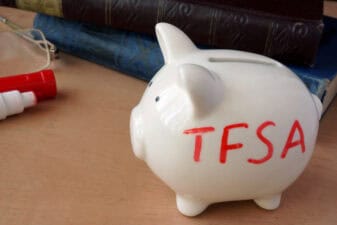Do you want to get $5,000 in annual passive income?
It’ll take some saving, but it can be done. The average yield on the S&P/TSX Dividend Index is 3.36%, which can get you to $5,000 per year in annual passive income. In this article, I will explore how much you need to invest at a 3.36% yield to get $5,000 a year.
About $148,809
$148,809 invested at a 3.36% yield is $5,000 per year. 3.36% is the yield on the S&P/TSX Dividend Index, and $5,000 divided by 0.0336 is roughly $148,809. If you save $10,000 per year, you can get to $148,809 in total savings in 15 years, plus or minus a few years, depending on how well your investments perform in the interim period between now and when you hit $148,809. If the stock market keeps delivering positive returns, then you will, in practice, reach the required amount in fewer than 15 years.
Can you do better?
$148,809 is a very attainable amount of savings. However, it will take over a decade to get there if your savings power is roughly $10,000 per year. You may feel a bit demoralized that it will require so much savings to get to $5,000 per year, a sum that’s not even enough to live off of.
Well, if you choose your investments well, it’s possible to perform better than the stock market averages. It is not an easy thing to do: it requires investing consistently in stocks that you have meticulously researched and determined to be of superior quality. Beating the broad market indexes on total returns is a professional-calibre achievement, one that entails above-average risk. Simply beating the index yield can be done with relative safety. It simply requires that you find a stock with an above-average yield, stable return prospects, and a modest payout ratio.
Consider Fortis (TSX:FTS), for example. It’s a Canadian utility company that makes 98% of its money from regulated utilities. Regulated utilities have very stable revenue because they provide an essential service and are protected by government regulations (a barrier to entry). Utilities do not always deliver superior total returns, but they pay out fairly reliable dividends most of the time. Fortis has not only paid but raised its dividend for 50 consecutive years. It has also outperformed both the TSX Composite Index and the TSX Utilities Sub-Index over most timeframes.
How has Fortis earned such a distinguished track record?
Well, to start off with, there are certain advantages to being a regulated utility. It ensures that customer money keeps coming in and that competition stays at a minimum. That alone is enough to keep the revenue coming in at a steady and slightly growing pace.
Second, Fortis has invested in growth over the years. It has bought utilities in Canada, the U.S., and the Caribbean. It has bought renewable assets. It’s currently increasing its rate base through its capital expenditure program. Put simply, it is one utility that hasn’t rested on its laurels but has instead invested in growth. That has resulted in it outperforming its fellow Canadian utilities by a wide margin.
Fortis stock has a 4.5% dividend yield at today’s prices. To get $5,000 per year at that yield requires just $111,111 invested. So, Fortis could get you to $5,000 in annual passive income faster than the TSX dividend index could.
| COMPANY | RECENT PRICE | NUMBER OF SHARES | DIVIDEND | TOTAL PAYOUT | FREQUENCY |
| Fortis | $53.25 | 2,084 | $0.60/quarter ($2.40/year) | $1,250/quarter ($5,000/year) | Quarterly |








